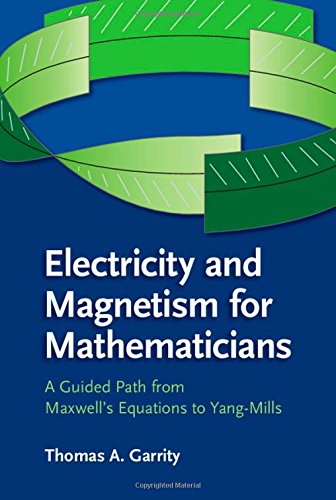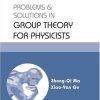(Ebook PDF) Electricity and Magnetism for Mathematicians A Guided Path from Maxwell’s Equations to Yang Mills 1st Edition by Thomas Garrity ISBN 9781316235089, 1316235084 full chapters
$50.00 Original price was: $50.00.$35.00Current price is: $35.00.
(Ebook PDF) Electricity and Magnetism for Mathematicians A Guided Path from Maxwell’s Equations to Yang Mills 1st Edition by Thomas A. Garrity -Ebook PDF Instant Download/Delivery:9781316235089, 1316235084
Instant download Full Chapter of Electricity and Magnetism for Mathematicians A Guided Path from Maxwell’s Equations to Yang Mills 1st Edition after payment

Product details:
ISBN 10:1316235084
ISBN 13:9781316235089
Author: Thomas A. Garrity
Table of Contents:
-
A Brief History
1.1 Pre-1820: The Two Subjects of Electricity and Magnetism
1.2 1820–1861: The Experimental Glory Days of Electricity and Magnetism
1.3 Maxwell and His Four Equations
1.4 Einstein and the Special Theory of Relativity
1.5 Quantum Mechanics and Photons
1.6 Gauge Theories for Physicists: The Standard Model
1.7 Four-Manifolds
1.8 This Book
1.9 Some Sources -
Maxwell’s Equations
2.1 A Statement of Maxwell’s Equations
2.2 Other Versions of Maxwell’s Equations
2.2.1 Some Background in Nabla
2.2.2 Nabla and Maxwell
2.3 Exercises -
Electromagnetic Waves
3.1 The Wave Equation
3.2 Electromagnetic Waves
3.3 The Speed of Electromagnetic Waves Is Constant
3.3.1 Intuitive Meaning
3.3.2 Changing Coordinates for the Wave Equation
3.4 Exercises -
Special Relativity
4.1 Special Theory of Relativity
4.2 Clocks and Rulers
4.3 Galilean Transformations
4.4 Lorentz Transformations
4.4.1 A Heuristic Approach
4.4.2 Lorentz Contractions and Time Dilations
4.4.3 Proper Time
4.4.4 The Special Relativity Invariant
4.4.5 Lorentz Transformations, the Minkowski Metric, and Relativistic Displacement
4.5 Velocity and Lorentz Transformations
4.6 Acceleration and Lorentz Transformations
4.7 Relativistic Momentum
4.8 Appendix: Relativistic Mass
4.8.1 Mass and Lorentz Transformations
4.8.2 More General Changes in Mass
4.9 Exercises -
Mechanics and Maxwell’s Equations
5.1 Newton’s Three Laws
5.2 Forces for Electricity and Magnetism
5.2.1 F=q(E+v×B)F = q(E + v times B)F=q(E+v×B)
5.2.2 Coulomb’s Law
5.3 Force and Special Relativity
5.3.1 The Special Relativistic Force
5.3.2 Force and Lorentz Transformations
5.4 Coulomb + Special Relativity + Charge Conservation = Magnetism
5.5 Exercises -
Mechanics, Lagrangians, and the Calculus of Variations
6.1 Overview of Lagrangians and Mechanics
6.2 Calculus of Variations
6.2.1 Basic Framework
6.2.2 Euler-Lagrange Equations
6.2.3 More Generalized Calculus of Variations Problems
6.3 A Lagrangian Approach to Newtonian Mechanics
6.4 Conservation of Energy from Lagrangians
6.5 Noether’s Theorem and Conservation Laws
6.6 Exercises -
Potentials
7.1 Using Potentials to Create Solutions for Maxwell’s Equations
7.2 Existence of Potentials
7.3 Ambiguity in the Potential
7.4 Appendix: Some Vector Calculus
7.5 Exercises -
Lagrangians and Electromagnetic Forces
8.1 Desired Properties for the Electromagnetic Lagrangian
8.2 The Electromagnetic Lagrangian
8.3 Exercises -
Differential Forms
9.1 The Vector Spaces Λk(Rn)Lambda^k(mathbb{R}^n)Λk(Rn)
9.1.1 A First Pass at the Definition
9.1.2 Functions as Coefficients
9.1.3 The Exterior Derivative
9.2 Tools for Measuring
9.2.1 Curves in R3mathbb{R}^3R3
9.2.2 Surfaces in R3mathbb{R}^3R3
9.2.3 kkk-Manifolds in Rnmathbb{R}^nRn
9.3 Exercises -
The Hodge ∗*∗ Operator
10.1 The Exterior Algebra and the ∗*∗ Operator
10.2 Vector Fields and Differential Forms
10.3 The ∗*∗ Operator and Inner Products
10.4 Inner Products on Λk(Rn)Lambda^k(mathbb{R}^n)Λk(Rn)
10.5 The ∗*∗ Operator with the Minkowski Metric
10.6 Exercises -
The Electromagnetic Two-Form
11.1 The Electromagnetic Two-Form
11.2 Maxwell’s Equations via Forms
11.3 Potentials
11.4 Maxwell’s Equations via Lagrangians
11.5 Euler-Lagrange Equations for the Electromagnetic Lagrangian
11.6 Exercises -
Some Mathematics Needed for Quantum Mechanics
12.1 Hilbert Spaces
12.2 Hermitian Operators
12.3 The Schwartz Space
12.3.1 The Definition
12.3.2 The Operators q(f)=xfq(f) = xfq(f)=xf and p(f)=−idfdxp(f) = -i frac{df}{dx}p(f)=−idxdf
12.3.3 S(R)mathcal{S}(mathbb{R})S(R) Is Not a Hilbert Space
12.4 Caveats: On Lebesgue Measure, Types of Convergence, and Different Bases
12.5 Exercises -
Some Quantum Mechanical Thinking
13.1 The Photoelectric Effect: Light as Photons
13.2 Some Rules for Quantum Mechanics
13.3 Quantization
13.4 Warnings of Subtleties
13.5 Exercises -
Quantum Mechanics of Harmonic Oscillators
14.1 The Classical Harmonic Oscillator
14.2 The Quantum Harmonic Oscillator
14.3 Exercises -
Quantizing Maxwell’s Equations
15.1 Our Approach
15.2 The Coulomb Gauge
15.3 The “Hidden” Harmonic Oscillator
15.4 Quantization of Maxwell’s Equations
15.5 Exercises -
Manifolds
16.1 Introduction to Manifolds
16.1.1 Force = Curvature
16.1.2 Intuitions behind Manifolds
16.2 Manifolds Embedded in Rnmathbb{R}^nRn
16.2.1 Parametric Manifolds
16.2.2 Implicitly Defined Manifolds
16.3 Abstract Manifolds
16.3.1 Definition
16.3.2 Functions on a Manifold
16.4 Exercises -
Vector Bundles
17.1 Intuitions
17.2 Technical Definitions
17.2.1 The Vector Space Rkmathbb{R}^kRk
17.2.2 Definition of a Vector Bundle
17.3 Principal Bundles
17.4 Cylinders and Möbius Strips
17.5 Tangent Bundles
17.5.1 Intuitions
17.5.2 Tangent Bundles for Parametrically Defined Manifolds
17.5.3 T(R2)T(mathbb{R}^2)T(R2) as Partial Derivatives
17.5.4 Tangent Space at a Point of an Abstract Manifold
17.5.5 Tangent Bundles for Abstract Manifolds
17.6 Exercises -
Connections
18.1 Intuitions
18.2 Technical Definitions
18.2.1 Operator Approach
18.2.2 Connections for Trivial Bundles
18.3 Covariant Derivatives of Sections
18.4 Parallel Transport: Why Connections Are Called Connections
18.5 Appendix: Tensor Products of Vector Spaces
18.5.1 A Concrete Description
18.5.2 Alternating Forms as Tensors
18.5.3 Homogeneous Polynomials as Symmetric Tensors
18.5.4 Tensors as Linearizations of Bilinear Maps
18.6 Exercises -
Curvature
19.1 Motivation
19.2 Curvature and the Curvature Matrix
19.3 Deriving the Curvature Matrix
19.4 Exercises -
Maxwell via Connections and Curvature
20.1 Maxwell in Some of Its Guises
20.2 Maxwell for Connections and Curvature
20.3 Exercises -
The Lagrangian Machine, Yang-Mills, and Other Forces
21.1 The Lagrangian Machine
21.2 U(1)U(1)U(1) Bundles
21.3 Other Forces
21.4 A Dictionary
21.5 Yang-Mills Equations
People also search:
garrity electricity and magnetism for mathematicians pdf
who is the father of electricity and magnetism
how does electricity and magnetism work together
what do electricity and magnetism have in common
how electricity and magnetism are related
Tags:
Thomas Garrity,Electricity,Magnetism,Mathematicians

